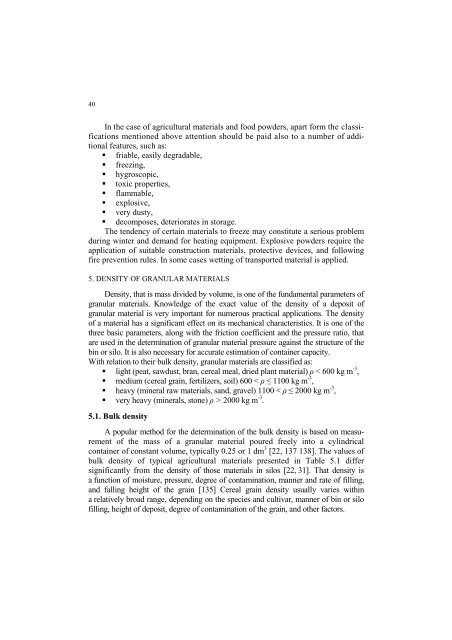Strona 2_redak - Instytut Agrofizyki im. Bohdana DobrzaÅskiego ...
Strona 2_redak - Instytut Agrofizyki im. Bohdana DobrzaÅskiego ...
Strona 2_redak - Instytut Agrofizyki im. Bohdana DobrzaÅskiego ...
You also want an ePaper? Increase the reach of your titles
YUMPU automatically turns print PDFs into web optimized ePapers that Google loves.
40<br />
In the case of agricultural materials and food powders, apart form the classifications<br />
mentioned above attention should be paid also to a number of additional<br />
features, such as:<br />
friable, easily degradable,<br />
freezing,<br />
hygroscopic,<br />
toxic properties,<br />
flammable,<br />
explosive,<br />
very dusty,<br />
decomposes, deteriorates in storage.<br />
The tendency of certain materials to freeze may constitute a serious problem<br />
during winter and demand for heating equipment. Explosive powders require the<br />
application of suitable construction materials, protective devices, and following<br />
fire prevention rules. In some cases wetting of transported material is applied.<br />
5. DENSITY OF GRANULAR MATERIALS<br />
Density, that is mass divided by volume, is one of the fundamental parameters of<br />
granular materials. Knowledge of the exact value of the density of a deposit of<br />
granular material is very <strong>im</strong>portant for numerous practical applications. The density<br />
of a material has a significant effect on its mechanical characteristics. It is one of the<br />
three basic parameters, along with the friction coefficient and the pressure ratio, that<br />
are used in the determination of granular material pressure against the structure of the<br />
bin or silo. It is also necessary for accurate est<strong>im</strong>ation of container capacity.<br />
With relation to their bulk density, granular materials are classified as:<br />
light (peat, sawdust, bran, cereal meal, dried plant material) ρ < 600 kg m -3 ,<br />
medium (cereal grain, fertilizers, soil) 600 < ρ ≤ 1100 kg m -3 ,<br />
heavy (mineral raw materials, sand, gravel) 1100 < ρ ≤ 2000 kg m -3 ,<br />
very heavy (minerals, stone) ρ > 2000 kg m -3 .<br />
5.1. Bulk density<br />
A popular method for the determination of the bulk density is based on measurement<br />
of the mass of a granular material poured freely into a cylindrical<br />
container of constant volume, typically 0.25 or 1 dm 3 [22, 137 138]. The values of<br />
bulk density of typical agricultural materials presented in Table 5.1 differ<br />
significantly from the density of those materials in silos [22, 31]. That density is<br />
a function of moisture, pressure, degree of contamination, manner and rate of filling,<br />
and falling height of the grain [135] Cereal grain density usually varies within<br />
a relatively broad range, depending on the species and cultivar, manner of bin or silo<br />
filling, height of deposit, degree of contamination of the grain, and other factors.
















